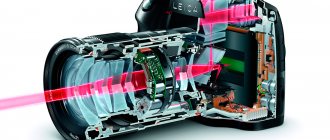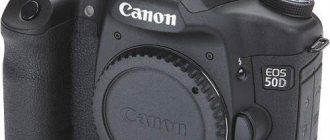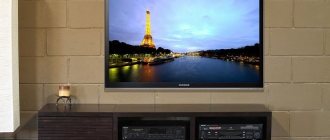What is a SLR camera?
A DSLR is a camera whose viewfinder is based on a mirror. In general, there are single-lens and double-lens SLR cameras. But since in the world of digital photography there is only room left for the first type, it will be discussed further.
The first single-lens reflex camera appeared in 1861. Yes, while serfdom had just been abolished in Russia, the camera had already been invented in England. That is, the history of the SLR camera began in the century before last, more than 150 years ago.
Of course, the first SLR cameras were very different from what we have now. One of the differences is the use of film. Today, film, as you all know very well, is practically extinct and exists only thanks to enthusiasts who fell in love with film photography once upon a time. Digital technologies have made it possible to replace the film in the camera with a matrix.
Let's return to the design of a SLR camera. Every DSLR has a mirror-based viewfinder. The mirror stands at an angle of 45 degrees and allows you to see a real non-digitized image through the viewfinder. The mechanism, in general, is quite simple from the point of view of understanding. Through the lens, light (and the image, respectively) enters the camera body, where a mirror is installed at an angle of 45 degrees. The light reflected by the mirror rushes upward, where it enters a pentaprism (or pentamirror), which wraps around the image, giving it its normal orientation. Simply put, if there were no pentaprism, the image in the viewfinder would appear upside down. That's all. This is the optical viewfinder - a distinctive feature of any DSLR.
What is a mirrorless camera?
A mirrorless camera, just like a DSLR camera, has interchangeable lenses. But, as you understand from the name, it does not have a mirror viewfinder. Inexpensive cameras use a screen instead of a viewfinder, while more expensive cameras use an electronic viewfinder. In fact, unlike an optical viewfinder, such a viewfinder shows us a digitized image. We can say that this is a small screen. It has a certain resolution, which is indicated in the camera specification. Naturally, as with a monitor, the higher the resolution, the better.
Why is a DSLR camera better than a mirrorless camera?
Let's first talk about why a DSLR is better than a mirrorless one.
- An optical viewfinder is not only a feature of a DSLR camera, but also its advantage over a mirrorless one. There are several reasons for this. First, the optical viewfinder shows the image in real time, raw and undigitized. That is, as your eye would see it without a viewfinder. Secondly, when using an electronic viewfinder there is a slight delay in the image, which is not present with an optical viewfinder. Those. with the latter you always see the picture in real time.
- Phase detection autofocus is unique to DSLR cameras. The latest models of mirrorless cameras have learned to use phase sensors on the matrix, thereby giving birth to a hybrid focusing system, but today it still does not reach the focusing speed of a SLR camera.
- DSLRs have better ergonomics This is due, among other things, to the fact that the mirror itself with the pentaprism takes up quite a lot of space in the carcass. Because of this, in fact, these cameras are so large. But this minus turns into a plus when you need to control the camera: especially professional cameras have excellent access to all important functions using buttons, wheels and other controls located on the body. Particularly noteworthy is the additional monochrome display, which is found in large SLR cameras and is never found in mirrorless cameras. This display is very helpful in professional photography, and it is never superfluous for amateur photography.
- Huge optics park . Remember when we said that SLR cameras have been produced for a century and a half? Nikon began producing cameras in the 50s of the twentieth century. Today, Nikon's optics fleet is huge and continues to grow. Of course, mirrorless cameras are still far from achieving such richness.
- DSLR cameras are generally less expensive Specific example. There is a Nikon D5100 with a Nikon 35mm 1.8G DX lens. This is a very inexpensive kit, costing less than 20 thousand. To get similar quality with a mirrorless camera you need to spend a lot more money.
- A DSLR camera turns on much faster than a mirrorless camera. In a split second, while mirrorless cameras can turn on in 3 seconds.
- life of DSLR cameras is significantly longer than that of mirrorless cameras. And the batteries themselves are usually more capacious. Thus, amateur cameras like the Nikon D7100 can shoot one and a half thousand frames on a single charge. Professional equipment, like the Nikon D4, can take more than 3 thousand pictures with a single battery charge.
- DSLR cameras are more reliable . Some of them have dust and moisture protection. This is why you are unlikely to see a photographer with a Sony A7 in the savannah. But with Canon 1Dx there is nothing to do. There are more of them there than lions and bison...
So, the main thing: today, professional shooting with a mirrorless camera is almost impossible.
A DSLR camera is preferable for commercial photography. And the amateur must decide for himself whether the advantages of a DSLR are important to him, or whether what a mirrorless camera offers is enough. More on this below.
Mirrorless cameras vs DSLRs or Why DSLR cameras are doomed
First, a little about the ins and outs of DSLRs. This unspoken nickname “stuck” to them due to the structural features - one of the main characters in the design of cameras of this kind is the moving mirror mechanism. It is used to ensure visibility of the field of the future frame in the optical viewfinder window
. Reflecting from the mirror, the light is reflected two more times through the faces of the pentaprism and only then enters directly into the viewfinder. When you press the shutter button, the mirror is removed from the path of the light stream so that it can easily penetrate the camera matrix. Moreover, the moment of shooting itself remains invisible in the viewfinder, since the raised mirror covers the matte focusing screen. In fact, the mirror mechanism is only an auxiliary element in the process of creating a photograph. Due to its bulky size, DSLR cameras are destined to be large and heavy. With mirrorless cameras getting on their feet, you can safely do without this mechanism.
| A clear difference between the operating principles of DSLRs and mirrorless cameras. |
Mirrorless cameras are good because the light flow is directed directly to the image sensor, bypassing all intermediate links in the chain. Accordingly, they have a simpler design, fewer fragile elements in it and, importantly, more attractive weight and size indicators. One of the main trump cards up the sleeves of mirrorless cameras:
Compact dimensions
With similar technical data, a DSLR of similar dimensions to a system camera with interchangeable lenses simply cannot be found. What can I say, the youngest of the mirrorless squad are practically indistinguishable in size from the average “digital point-and-shoot cameras”
, especially in combination with any of the “pancake” lenses. In addition, due to their short flange length, mirrorless cameras often use more compact optics, which eliminates the need to carry a whole suitcase of camera equipment with you when shooting.
| Some of the most compact mirrorless cameras on the market are classified as the Olympus PEN series. |
A small camera coupled with a compact lens attracts less attention to oneself, which is important in the genre of street photography, and takes up minimal space. True, for the sake of compactness, many of the mirrorless cameras in the entry-level and mid-segment lack a comfortable grip. DSLRs with ergonomics fare a little better, since their more massive body leaves enough space for both the handle and additional quick access buttons along with the control wheels.
Popular compact cameras Sony ZV-1 from RUB 49,700. Sony RX100 VII from RUR 71,900 Sony RX100 VI from RUR 57,000 Sony RX100 III from RUR 35,900 Olympus TG-6 from RUR 33,790 Canon PowerShot G9X Mark II from RUR 27,500 Canon PowerShot G7X Mark II from RUR 34,500 Canon PowerShot SX620 HS from RUR 17,490. Sony RX100 V from RUR 48,990 Fuji FinePix X100V from 96,050 rub. Canon PowerShot G7X Mark III from 43,000 rub. Panasonic DMC-TZ100 from 34,200 rub. Canon IXUS 185 from RUR 7,999 Panasonic DC-ZS200 from 47,400 rub. Sony W830 from 7,100 rub. Panasonic DMC-TZ80 from 22,900 rub. Sony WX350 from 16,000 rub. Nikon Coolpix S9900 from RUR 17,900 Sony RX100 from 25,000 rub. Canon PowerShot G1 X Mark III from RUR 54,800
Electronic viewfinder
Through the viewfinder window on board mirrorless cameras you can see the frame as it will turn out in the end. The image on the viewfinder screen is displayed from the matrix, taking into account the shutter speed and aperture settings, photosensitivity, white balance and exposure compensation
. In addition, it can display a lot of related shooting parameters to help the photographer, for example, a histogram. You are also offered to view on the main screen - there are no differences in this matter.
Good to know.
For the sake of accessibility, many entry-level mirrorless cameras do not have a viewfinder in their design, and the rear screen plays the role of a “universal soldier”. The display on the back of the camera body is used for sighting during shooting, changing parameters and viewing the footage.
| The “eye” of the optical viewfinder sees the image in the image and likeness of the human eye, and in the electronic viewfinder window the picture is shown taking into account the selected shooting parameters. |
For DSLRs with a mode for displaying the field of the future frame on the display, everything is much more complicated. This is due to the focusing features - when using the automatic focusing system in Live View mode, the camera works with the mirror raised, using less efficient contrast focusing. Those. A DSLR camera in this form is an analogue of a mirrorless camera, and not the fastest and most responsive.
At first, many mirrorless cameras were plagued by the problem of image inertia in the viewfinder and on the screen, which made them unsuitable for shooting highly dynamic scenes (reports from sporting events, shooting objects in motion, etc.). However, today, for the lion's share of current models, the refresh rate has increased significantly and the delay in transmitting the image to the camera display is negligible - it is not possible to see it with the naked eye.
Matrix stabilization
A strong argument in favor of many mirrorless cameras is the matrix stabilization system. The image sensor in mirrorless cameras with a matrix stub is mounted on a movable stabilizing platform.
Compensation for the camera's displacement trajectory is carried out by moving the platform with the matrix in a plane perpendicular to the optical axis of the lens. Such a stabilization system is good because it operates in conjunction with any optics, regardless of whether it has its own optical stub on board. In the most advanced mirrorless cameras, the matrix stub is capable of compensating up to 7 steps of exposure when shooting handheld or in low light conditions. A striking example of such a camera is the pro-tool Olympus OM-D E-M1X body Price from 148,990 to 179,990 rubles.
| The matrix stub in the arsenal of mirrorless cameras significantly simplifies handheld shooting at critical shutter speeds and helps in obtaining smooth footage when recording video. |
In the DSLR family, a similar system is found only on board models from Sony and Pentax, which cannot be called “purebred” DSLRs. This is due to the use of a translucent mirror and an electronic viewfinder in their design.
Popular cameras with image stabilizer
Sony A7 III body from RUR 123,900 Sony A7 III 28-70 from 125,900 rub. Sony a7C body from RUR 122,500 Nikon Z5 body from RUR 77,700 Sony a7C kit from RUB 136,000 Canon EOS 6D Mark II body from 88,000 rub. Canon EOS R6 body from RUR 180,490 Sony ZV-1 from 49,700 rub. Sony A7r III body from RUR 151,300 Nikon Z5 kit from RUR 91,500 Sony A7r IV body from RUR 201,200 Sony A7s III body from RUR 307,700 Nikon Z6 II body from RUR 130,900 Canon EOS R5 body from RUR 281,190 Fuji X-T4 body from RUR 109,600 Nikon Z6 kit from RUB 117,800 Sony H300 from 6,700 rub. Sony A7 II body from 76,400 rub. Sony A6600 body from 94,900 rub. Fuji X-S10 kit 18-55 from 96,200 rub.
No back and front focus problems
Focus sensors in mirrorless cameras are located directly on the plane of the matrix, due to which they managed to solve the eternal problem of back and front focus
. Both of these phenomena are unique to DSLR cameras and arise due to a mismatch between the autofocus sensor and the mirror.
Reference.
Back focus is an error in the autofocus system that causes the camera to focus behind the subject. Front focus is a similar mistake with the only caveat that focusing occurs in front of the subject.
At the dawn of their development, mirrorless cameras using the contrast autofocus method were significantly inferior in focusing speed to their mirror counterparts. However, with the development of hybrid autofocus systems, the problem has been eliminated. For example, the top-end mirrorless camera Canon EOS R body Price from 107,500 to 232,450 rubles. captures the subject in just 0.05 seconds, and has 5655 focusing points. The closest DSLR relative of the camera, the Canon EOS 1DX Mark II, has only 61 of them, despite the fact that the camera is positioned as a real reportage “monster”.
Video shooting
Thanks to built-in autofocus sensors and matrix stabilization, mirrorless cameras are much better suited for video shooting than DSLRs.
. Particularly successful in terms of video capabilities are Panasonic cameras and the Sony A7s series of full-frame flagships in all three generations.
Video shooting in 4K is the destiny of most mirrorless cameras, while in the “mirror world” recording videos in UltraHD resolution is the prerogative of top-segment devices.
Autonomy
The only point in the program where mirrorless cameras are inferior is battery life. The “gluttony” of mirrorless cameras is explained by the use of an LCD screen or an electronic viewfinder display for sighting and viewing captured images
. DSLRs allow you to shoot without their participation, with your eye glued to the optical viewfinder window.
| Many of the mirrorless cameras can be powered with life-giving energy in the field using an external battery. |
Most mirrorless cameras can take 300-400 pictures on a single battery charge, while for a group of DSLR cameras this figure is often 2-3 times higher.
Popular SLR cameras
Canon EOS 600D Kit 18-55 from RUR 13,900 Canon EOS 6D Mark II body from 88,000 rub. Canon EOS 250D kit from RUR 34,700 Canon EOS 6D body from RUR 49,200 Nikon D750 body from RUR 72,990 Canon EOS 2000D kit 18-55 from RUR 22,400 Canon EOS 650D kit 18-55 from RUR 16,400 Canon EOS 200D kit 18-55 from RUR 32,500 Canon EOS 5D Mark IV body from RUR 148,690 Nikon D5300 kit 18-55 + 70-300 from 25,120 rub. Canon EOS 90D body from RUR 76,500 Canon EOS 5D Mark III body from RUR 79,150 Nikon D610 body from 51,000 rub. Nikon D5300 kit 18-55 from 24,800 rub. Nikon D5600 kit 18-55 from 37,400 rub. Canon EOS 5D Mark II body from RUR 40,900 Nikon D3300 kit 18-55 from 16,700 rub. Nikon D5200 kit 18-55 from 17,000 rub. Canon EOS 800D kit 18-55 from RUR 44,900 Nikon D3500 kit 18-55 from 24,500 rub.
What's the result?..
The fact that mirrorless cameras are the future is beyond doubt. Such eminent photo brands as Fujifilm, Sony and Olympus, together with Panasonic, came to this long ago, which were completely reformatted for the production of mirrorless cameras.
| A couple of debutants from Nikon in the field of mirrorless cameras with a full-frame image matrix. |
2021 can also be considered a turning point for mirrorless cameras, when first-tier manufacturers entered the arena of the top segment - Japanese companies Nikon with full-frame Nikon Z6 body Price from 90,500 to 154,900 rubles. and Nikon Z7 body Price from 135,700 to 238,958 rubles, as well as the brainchild of the Canon company called Canon EOS R body Price from 107,500 to 232,450 rubles. Before them, for many years in a row, the palm in the flagship category of system cameras with interchangeable optics were tightly held in a tight grip by a series of full-frame mirrorless cameras from Sony (A7 line and flagship Sony A9 body Price from 212,500 to 299,990 rubles). There are a couple more notable products in the Fuji portfolio - Fuji GFX-50S body cameras Price from 339,900 to 359,990 rubles. and Fuji GFX-50R body Price from 257,000 to 305,000 rubles. represent the medium format camera league.
The share of mirrorless camera sales on a global scale is growing inexorably every year. Initially aimed at enthusiast photographers, they are acquiring new functions and becoming more and more professional, which makes even avid “conservatives” turn their attention to the group of mirrorless cameras. And the calling of the public, you see, is a significant plus in the karma of system cameras with interchangeable lenses and the path to their further success.
Good luck with your shooting!
Why is a mirrorless camera better than a DSLR?
Yes, but are there any advantages to a mirrorless camera that a DSLR camera doesn’t have? Eat. And now we will talk about them.
Olympus technology is one of the most popular mirrorless cameras on the market
- Size . This is the most obvious. Mirrorless cameras are smaller. The optics for such cameras are also more compact. As a result, you can get a mirrorless system that will be smaller than a DSLR, but will allow you to get the same high-quality images.
- Electronic viewfinder . Electronic viewfinders also have their advantages. Firstly, they can display various additional information. Secondly, such viewfinders will be more convenient for nearsighted people. You need to use the optical viewfinder with glasses or use the diopter correction function, which is enough for vision of -2.5, but if the minus is greater, then alas. The electronic viewfinder, as we said above, is a screen. And, of course, when used by a nearsighted person, there are no problems with it.
- Large selection of manufacturers . Mirrorless cameras are now produced by the following companies: Nikon, Canon, Sony, Panasonic, Olympus, Fujifilm, Samsung. But affordable DSLRs are produced only by the first 3 companies plus Pentax.
What do DSLR and mirrorless cameras have in common?
There is one thing that these cameras have in common.
- Matrix . The most important part of a digital camera. Just a couple of years ago, I would have said that mirrorless cameras do not have a full-frame sensor. But Sony corrected this by releasing the A7 series cameras. They have matrices that are not inferior to those used in SLR cameras. We have already talked about matrices more than once; there is no need to repeat ourselves.
- Systematicity . For some reason, many people call mirrorless cameras system cameras, forgetting that DSLR cameras also belong to this class. This is the similarity between DSLRs and mirrorless cameras - these are system cameras that feature interchangeable optics.
When to switch to a mirrorless camera
Content:
Introduction
Hello! In this article, I will try to weigh the various aspects of the advisability of switching to mirrorless cameras in 2021. The final answer to the question “When to switch to a mirrorless camera?” still remains up to the reader. Every year the answer seems to become obvious. Some photographers, both amateurs and professionals, have a clear answer - “Yes, it’s worth it.” Please note that only some have, and according to my observations, some are not that many yet. There is also some buzz online and a deliberate emphasis on the benefits of mirrorless systems. However, mirrorless cameras are very diverse in level and quality, as are the nuances of switching to them. However, SLR cameras are just as diverse, and they are still developing. Yes, new technologies are also being developed and received. And yet, sometimes, there is a certain feeling that we are being transferred to another platform. Whether we like it or not.
What affects image quality in cameras?
Generally speaking, the quality is primarily affected by the matrix and optics. Optics have a big impact. Often, beginners, when choosing a camera, try to place maximum emphasis on the body (the camera itself), on its megapixels, on the maximum permissible noise of the matrix, and leave the purchase of acceptable optics for later. It turns out that an excellent camera from such a beginner shows modest results compared to a camera of a lower class, from an experienced photographer who relied on optics. Therefore, optics is primary.
The Canon brand is most familiar to me, so there are references to this brand in the article. But general decision-making principles apply to most cases.
Imagine, there are optics whose resolution is much lower than the resolution of your matrix, color rendition is very poor. The matrix follows. Of course, the matrix also affects the quality, but it can reveal itself no more than the optics allow it to do so. And this rule applies to both DSLR and mirrorless cameras. It is not the mirror or mirrorless, and not even the body of the camera as a whole that determines the image, but the optics! More precisely, first the optics, and then the matrix. The image passes through the optics onto the matrix. Bad optics means bad image.
Therefore, an initial APS-C mirrorless camera with some cheap kit lens, ala 15-45, will not offer anything interesting compared to an advanced SLR camera with a modern matrix and semi-professional or professional optics, when the price of one lens is comparable to the body of the camera. The opposite is also true - top-end optics on a budget carcass will give a noticeable gain in quality, compared to very decent optics with mediocre optics.
In this aspect, mirrorless and DSLR cameras are equal. If both cameras have the same optics and the same sensor sizes, then with today’s level of matrix development, the images from such cameras will be the same, all other things being equal. Of course, there are other nuances besides matrices and optics. For example, the focusing system. But more on that later.
Even with different years of sensor production, within reason, of course, optics will have a significant impact on the image. Low-resolution and low-contrast optics will blur the image, and the matrix will not be able to add details, no matter how good it is.
Matrices of different sizes produce different working ISOs.
Working ISO is the maximum allowable sensitivity of the matrix without noticeable image degradation.
As a rule, modern (from 2016) APS-C format matrices allow you to get a working ISO of about 900-1600 units. And Full Frame format matrices are 3200 - 6400. Sensors produced before 2012-2013 could work with working ISO 400-500 and 900-1600, respectively. As you can see, we are not talking about DSLR and mirrorless here either. The image is also affected by the sensor. Its working ISO. Of course, the sensor has other parameters that affect the image. Now I am not considering them, since all modern APS-C and FullFrame sensors have reached a very high level in color reproduction, detail and dynamic range.
If I were thinking of buying a new camera, then it would be more important for me to move to a new level of operating ISO, a new level of optical resolution and a new level of camera durability, moisture protection, and, if possible, level of functionality. The level of the focusing system is also important. It is advisable to start your choice with optics. See if it's worth using your optics on the new system. Is it possible. If optics are not available, you need to look at the range, price, and compatibility of the manufacturers. After choosing optics, we commit ourselves to the brand, camera line and mount. Sometimes you can choose two or more mounts using an adapter.
So we looked at two significant elements of the camera that affect the image: optics and matrix. Let's move on to something equally important - focusing.
Focus system
Focusing affects image quality not directly, like optics and sensor, but in the end it is quite significant. Nowadays, almost all photographers, in most situations, use automatic focusing in their cameras. And the result of the work depends on how she completes her task. How many photos will be sharp where intended, and how many will be scrapped due to an autofocus miss?
In addition to the accuracy of the focusing system, there are many other quality parameters to keep in mind. Focusing speed, work in low light, flexibility of settings, ease of use, efficiency (how quickly and easily it can be reconfigured by the photographer), additional convenient functions. The result of the focusing system is the percentage of successful focusing.
The number of settings needed, the speed, efficiency and flexibility of the camera focusing system affects the ability to capture moments and the ease of working with the camera. This is also a very important parameter when the photographer does not become overtired from struggling with the focusing system, but enjoys the work and a large percentage of photographs suitable for selection.
Focusing system of modern DSLRs
Modern DSLR cameras use two focusing systems
The first and main one is phase sensors located at a level below the main mirror. Let's call it an optical focusing system. In optical imaging mode, part of the light does not go into the viewfinder, but hits the chip with phase sensors. There can be quite a lot of them. For example, 45 or 60. But in lower systems there are fewer of them. For example, 9. The photographer is free to choose a specific sensor, group, or entrust the choice of sensor and group to automation. Now such systems are very developed. They work very accurately. But not perfect. Especially at open apertures.
The second focusing system of modern DSLRs is the matrix itself with phase focusing technology. Canon has this technology called Dual Pixel. Each subpixel of the matrix consists of two parts (A and B) and this is all organized in such a way that the entire matrix not only “sees” the image, but is also an area, roughly speaking, covered by phase sensors. In this mode (Live View mode), the focusing system of the DSLR camera works in conjunction with the electronic sight. The mirror is raised at this moment, and the photographer observes the image on the camera’s LCD screen. This phase focusing on the matrix works very accurately. Just like with BZK (mirrorless cameras).
There are old and budget cameras that work in Live View without Dual Pixel, by contrast. Old and slow technology. I don't consider them.
Focusing system of modern mirrorless cameras
Mirrorless cameras have only one focusing system - essentially the second focusing system of DSLRs. The same matrix with Dual Pixel with phase focusing, like modern DSLRs. Let's call it “matrix”, when the matrix is not only an image sensor, but also a phase sensor of the focusing system.
Advantages of the optical focusing system:
- low power consumption – the screen and matrix are not used;
- accuracy and speed on rapidly changing images;
- optical viewing – there are no various delays inherent in digital video transmission, a natural image in the viewfinder with maximum detail;
Disadvantages of the optical focusing system:
- probability of accurate operation ~ 70%;
- the need for sufficient qualifications of the photographer to obtain even ~70% accurate optical autofocus;
- a noticeable decrease in focusing accuracy when using small aperture values f0.9-f3.2;
- inability to focus beyond the central point (group of points) at open apertures f0.9-f3.2;
- the need for alignment of lenses with noticeable wear, lenses after repair and some new copies with a defect (a very rare case);
Advantages of matrix phase focusing:
- high probability of accurate operation (95%) with high-quality implementation of the system;
- high focusing accuracy at small aperture values f1.2 – f3.2;
- high focusing accuracy across the entire frame field;
- high focusing accuracy on lenses requiring adjustment for the optical focusing system;
- high quality tracking of moving objects with target designation;
- the ability to target an object;
- the ability to programmatically recognize various image elements;
- technical simplification of the camera - mirrors, pentaprism/pentamirror were removed;
- the ability to display images not only on the main display, but also on the viewfinder display (used in the UPC);
- no optical adjustment required;
Disadvantages of phase focusing on the matrix:
- high energy consumption;
- possible delay in electronic sighting of frames on budget systems;
- decreased accuracy/speed of focusing on rapidly changing scenes and fast moving objects;
- low speed and focusing accuracy on budget cameras;
- unstable focusing accuracy on the first generations of professional UPC cameras;
Disadvantages of focusing in Live View in DSLR cameras
They are worth mentioning separately. Although the Dual Pixel focusing system itself in a DSLR camera in Live View mode works exactly the same as in the BZK, the DSLR still has a certain delay between pressing the shutter and saving the photo. Those. Matrix focusing itself is fast and accurate, and even continuous shooting is possible with it. However, the slow response of a DSLR camera to the shutter release in Live View makes shooting dynamic reporting, and especially sports, problematic. We can say that a DSLR camera in Live View mode responds to the shutter release with a delay. Whether this is an intentional delay or from the manufacturer, for segmentation of camera models, or technical, I don’t know. But you need to remember this when choosing a camera. Nevertheless, 30% - 60% of all scenes are shot without problems in Live View on a DSLR camera and are in no way inferior to shooting on a mirrorless camera.
General comparison of DSLR and mirrorless cameras
Otherwise, a DSLR camera is practically no different from a mirrorless camera in Live View mode, with the exception of a single sight on the screen. In many mirrorless cameras, you can also view the frame using the electronic viewfinder. In a DSLR camera, the viewfinder is only available in optical focusing mode.
Essentially a mirrorless camera, as of 2021 it has slightly improved focus, in most not-so-fast tasks. It is also possible to reduce the weight of a mirrorless camera by removing the mirror and pentaprism. There are mirrorless ultra-compact cameras that are so compact in size that ergonomics, convenience, functionality, and good autofocus performance are not their thing. But they are great for travel.
The total focusing accuracy of a modern advanced SLR camera, with proper use of its two focusing systems (optical and matrix), can reach 80%. But this requires experience. If the photographer lacks experience, the percentage of focus hits on a DSLR camera is significantly lower. The comfort of working with such a focusing system is lower than on a powerful mirrorless camera. Is it worth switching to a mirrorless camera just because of a lack of experience? Comfort of working with equipment is also important. Especially in commercial photography. Think carefully about this question.
The focusing accuracy of an advanced mirrorless camera can reach 95%. However, a mirrorless camera tends to use more power. With the same battery, an advanced amateur SLR camera can produce ~1200 frames on a single charge, while a mirrorless camera of the same level can only produce ~350 ~400.
The electronic viewfinder of a mirrorless camera must have a high enough resolution and speed so that it can be used comfortably. It should not make confusing forward adjustments to the image when dynamic range is over-compressed and the photographer cannot see aesthetically correct light-and-shadow patterns through such a viewfinder.
Removing the mirrors, pentaprism and optical focusing system allows an advanced mirrorless camera to be lighter and more compact than a DSLR, as long as ergonomics are met. But the camera's dimensions are greatly influenced by optics. The bodies of modern APS-C DSLRs are very compact and lightweight. Place such a carcass on your palm. Does she weigh a lot? Almost nothing. Is she big? It can easily be placed in the palm of an adult's hand. So, the compactness of the UPC is not the only one of its kind. The compactness of cameras is generally relative due to the optics and class of the camera. Do you want budget compactness, coupled with excellent images and speed? The compact APS-C DSLR has not yet lost its relevance. On the other hand, the Canon EOS RP, the junior FullFrame mirrorless camera, is a very light and compact camera. Carcass. Optics can take up a lot of space and weigh quite a bit.
Relevance
A hypothetical disadvantage of a SLR camera can be considered a refusal, in the future, by manufacturers to develop new SLR cameras and further improve optics. A disadvantage can also be the additional weight and size (not significant, compared to full-fledged UPC).
But there are a lot of optics for DSLRs, of different levels, and at different prices. At least with Canon and Nikon. Optics for mirrorless cameras are still smaller and more often significantly more expensive, but their quality in some copies has been slightly improved. Look at optics and camera evaluation resources on the Internet. How many mirrorless optics have been tested (December 2020)? No.
If you look at the usage statistics for Canon cameras from photo hosting giant flickr, you will find that so far (December 2021) in the last month, DSLR cameras are the most used of the photos uploaded.
Even the well-known budget UPS Canon EOS RP flounders somewhere in the region of 20th place. And Canon EOS R, R5 and R6 are not to be seen at all in the top twenty. Canon EOS 5D, 6D of different generations dominate there.
See the section “Most Canon Uploads in the last Month”
(Which Canon models are tagged in images, recorded when uploading photos over the last month.)
As of January 3, 2021, the most popular cameras from Canon brands are EOS 5D Mark III, EOS 6D, EOS REBEL T3i, EOS 70D, EOS 60D. That there are no downloaded images tagged with mirrorless camera brands in the top five. This is due to the fact that for now people are satisfied with DSLRs. And the cameras have not exhausted their service life.
The “Top 5 Canon Cameras over the last Year” statistics tell us that as of January 2021, the EOS 5D Mark III, 6D EOS, REBEL T3i, 5D Mark II and 70D cameras are even in very good shape. They've been in use for about 5 years now. Mostly them. Although aggressive advertising of the BZK began around 2015-2016.
Those. People are pragmatists who own current DSLR cameras, which they are completely satisfied with, but are in no hurry to switch to mirrorless systems, for the most part. There are simply no significant advantages.
A few more interesting comparisons. A fairly advanced APS-C (crop DSLR) Canon EOS 90D (body) costs ($1150) approximately the same as the Full Frame mirrorless Canon EOS RP ($1100). How did this happen? So that crop (APS-C), and even a mirror one, costs the same as a full-frame UPC. It's all about the functionality, and accordingly, the level of the camera in terms of its parameters and capabilities. The situation is also ambiguous when comparing the Canon EOS 6D MK2 and Canon EOS RP cameras. At the same time, 6D MK2 was released in 2021. This is a DSLR. It is very cut down in order to fully work in a report, just like EOS RP. But EOS RP is newer. Essentially these are two amateur Full Frames. But the difference in architecture and years of release should also be felt in price. However, this does not happen. Bye. The price of the Canon EOS 6D MK2 DSLR camera starts at $1200, versus the Canon EOS RP $1100 (at the time of writing). Therefore, not everything is so simple. Switching to a mirrorless camera, changing the awl for soap, is not very interesting. Especially considering the financial costs.
It’s worth considering that if you buy a UPC, say Full Frame Canon, already owning a fleet of EF optics, then despite the presence of an adapter and the ability to install EF optics, you will still sooner or later buy native RF optics. In this case, when changing from EF optics to RF, you will have to remove the adapter and then reinstall it. Is it convenient for you to do this? Switching to a mirrorless camera with an old camera, if the adapter allows it, is possible, but what problems will this add? The main ones are that you will have to remove the adapter for the new optics and install it again for the old one. Every time. And if you are a fan of fixes, then this is a rather tedious task.
Is it worth switching to mirrorless?
You will have to answer this question yourself. Personally, I decided the following for myself.
From an old and inconvenient SLR camera, which in any case must be disposed of/donated/sold for next to nothing/placed on a shelf, I would switch to the BZK. More precisely, it would not be a transition, but the purchase of a new camera. Updating cameras cannot be called a transition.
At the same time, I would think ten times. And maybe I upgraded from an old DSLR to a new DSLR.
The fact is that complaints have already appeared on the network about focusing errors of advanced and expensive FullFrame UPCs, and the consistency of back and front focusing on them. But this is a BZK. And they can’t do anything in the services using the classical adjustment method. The manufacturer recommends that each lens be registered individually in the camera. More often this situation occurs on optics from DSLRs through an adapter. But re-buying the same optics with a different connector is very expensive. People also complain about the less responsiveness of the backup cameras and the actions of the photographer.
So much for the vaunted mirrorless.
If I only have an advanced APS-C camera in my arsenal, and it still suits me, and I would like to add Full Frame to my fleet of equipment, then I would consider the Full Frame UPC only after making sure that the focusing system is working properly and that the camera is sufficiently responsive . I don't need a slow camera. And this is also not a transition, but an expansion of the equipment fleet.
Now there is an active surge in messages on the network about a certain so-called. transition to the UPC. Just the transition. In the case when a suitable modern APS-C/Full Frame DSLR is sold and an APS-C/Full Frame mirrorless DSLR is bought, in my opinion, the difference is a bad one. Novelty for the sake of novelty. This is the best case scenario.
By the way, I’m not interested in APS-C mirrorless cameras yet as the main camera. But in third roles, in a purse for every day, just in case, they will do. No more. If you still look towards the UPC, leaving the advanced APS-C, then only towards Full Frame. Because, as advanced APS-C DSLRs, which can be used almost like a professional one. There are cameras, but there are still problems with similar ASP-C UPCs. The manufacturer even took them away from the edge of the professional direction.
With a modern advanced Full Frame DSLR, something like the Canon EOS 5D MK4, with many convenient functions, excellent resource, dual focusing system, I would not switch to the Full Frame BZK yet. What's the point? Big expenses in money, and the increase in functionality is doubtful. Yes, and other disadvantages will be added.
Photo: Vladislav Vasnetsov
Good non-slow mirrorless cameras with rich functionality cost from $2,600. Are they really that good? What will we get for such a transition? It depends on where we are moving from. From a good DSLR, when switching to a BZK, we will get a 20% improvement in focusing (instead of 75% - 95%. Only ideally. Remember the complaints). At the same time, we will notice some other deteriorations. For me, there is no point in the transition. But changing the old/weak one or adding a camera of a different level is definitely worth it.
In the future, manufacturers will most likely switch us all to mirrorless cameras. To replace an old and weak DSLR, I would buy a BZK only without lags and frequent focusing errors, which should not be there.
Move to new platforms thoughtfully!
All the best!
Home page » Technique »
When to switch to a mirrorless camera
Other publications:
- Color Management in RawTherapee
- Camera shooting modes. The two most basic ones.
- How to shoot with a zoom lens correctly
- Elikon-35SM. Cameras of my childhood
- Resolution in megapixels and DPI
- The advantage of a DSLR camera
What's better? DSLR or mirrorless?
There is no clear answer to this question. Everyone must make their choice based on their needs. My opinion is that DSLR cameras today are still too much superior to mirrorless cameras. For me personally, when choosing a camera, the most important criteria are speed (focusing, switching on), a wide selection of optics and price (both for the camera and lenses). Yes, you don’t always want to take a huge mirror set with you. It's better to have a choice. For example, for large (long, important, etc.) filming, have a DSLR, but for the soul - something small, maybe not even a mirrorless camera, but a compact camera like Fuji x100s or the like. But if you choose one single camera, then again, I would choose a DSLR. But that's just my opinion. What would you choose?
Related articles: Types of cameras How to choose a DSLR camera The best DSLR cameras 2014
Mirrorless camera: advantages and disadvantages
Share this article:
Not long ago, bulky SLR cameras were replaced by mirrorless cameras. This is logical, because the whole world is striving to simplify and make everything easier. The new camera does not have a mirror viewfinder, as in a regular one, and the output we get is not an optical, but an already digitized image. We will consider this and other advantages and disadvantages of the new product below.
Advantages of a mirrorless camera
The first and main plus is the size. Due to the lack of a flip-up optical mechanism, mirrorless cameras are much smaller than their predecessors. Accordingly, the lenses for them are much lighter. This is especially important for people for whom compactness comes first. The smaller the camera, the easier it is to take with you, the more convenient it is to hold and use.
The second advantage is that you immediately see the image that you will get in the end. If you take a DSLR camera and change the settings before shooting, the image will not change. You will see the result only after you finish filming. Mirrorless cameras use electronic viewfinders, thanks to which you will see the finished format immediately on the camera screen and can make adjustments if necessary. The electronic viewfinder also allows you to shoot at night.
Other advantages of mirrorless cameras are: fairly quiet operation due to the absence of a flip mechanism, a large selection of manufacturers and a small number of components, which increases the lifespan of the device.
Disadvantages of a mirrorless camera
Mirrorless cameras not only have a number of advantages, but also obvious disadvantages.
First, let's look at the battery. It is significantly weaker than that of DSLR cameras. This is due to the fact that their battery is used exclusively at the moment of shooting, and mirrorless cameras consume charge throughout the entire time they are turned on. Disadvantages include screen response time. That is, the picture on the display may slow down. There is a high probability of missing the moment while the screen lags behind for a split second. In addition, mirrorless cameras do not respond as instantly to your actions as their predecessor cameras.
Another disadvantage is the lack of additional accessories. These cameras have recently begun to flood the market and manufacturers simply have not had time to develop convenient devices to optimize and improve performance. Whether you should choose a mirrorless camera is up to you. It’s impossible to decide and choose yours without trying. If you want to hear the opinion of professionals and see for yourself which camera is right for you, sign up for courses at a photography school. Here you can make your choice and raise your professional level.
You can learn all the nuances of using mirrorless cameras, as well as master other types of photographic equipment, in the courses of the St. Petersburg School of Television.
Share this article:
I liked the article











